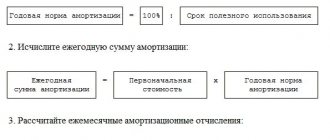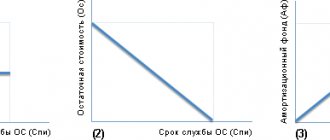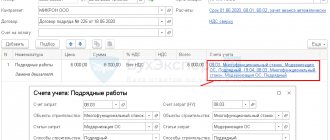The use of bonus depreciation is the right and not the obligation of the taxpayer (letter of the Ministry of Finance of Russia dated October 30, 2014 No. 03-03-06/1/55106, dated May 6, 2009 No. 03-03-06/2/94). Therefore, an organization that has decided to use this benefit must consolidate its choice in its tax accounting policy (paragraph 5 of Article 313 of the Tax Code of the Russian Federation). In addition, the accounting policy must reflect:
- the amount of depreciation bonus. Please note: the legislation establishes only the maximum amount - no more than 10 or 30 percent of the original cost of the OS or the cost of modernization, depending on which depreciation group it belongs to (clause 9 of Article 258 of the Tax Code of the Russian Federation). This means that the company has the right to charge a depreciation premium in smaller amounts within the limits provided for in paragraph 9 of Art. 258 Tax Code of the Russian Federation. At the same time, the organization is not obliged to justify the chosen amount of the bonus;
- criteria according to which the depreciation bonus will be applied to all or individual objects of depreciable property (letter of the Ministry of Finance of Russia dated October 30, 2014 No. 03-03-06/1/55106). In other words, the organization can choose the category of objects for which the benefit will be applied (letter of the Federal Tax Service of Russia for Moscow dated August 13, 2012 No. 16-15 / [email protected] ). For example, only real estate or vehicles, or all depreciable property. You can also use the cost of the object as a criterion (letter of the Ministry of Finance of Russia dated November 17, 2006 No. 03-03-04/1/779).
If the accounting policy does not provide for the use of bonus depreciation, tax authorities may exclude its amount from income tax expenses. This conclusion can be drawn from the letter of the Ministry of Finance of Russia dated September 23, 2008 No. 03-03-06/1/539. Note that the courts have a different opinion. Thus, the Federal Antimonopoly Service of the Ural District decided that the absence in the order on accounting policy of an indication of the right to apply the depreciation bonus and its amount is not a basis for not including these costs in expenses, since the tax legislation does not contain such a condition (resolution dated June 17, 2008 No. F09- 4302/08-C3). Similar conclusions are contained in other court decisions (decrees of the FAS Moscow District dated November 30, 2009 No. KA-A40/12576-09 in case No. A40-89853/08-141-432, FAS Central District dated October 28, 2009 in case No. A62- 5702/2008).
What is bonus depreciation of fixed assets
As a general rule, money spent on the purchase or creation of a fixed asset (FPE) is not written off as current expenses, but is included in the initial cost of the object.
But paragraph 9 of Article 258 of the Tax Code of the Russian Federation allows organizations to write off part of the amount as expenses (this is a depreciation bonus), and include the remaining funds in the initial cost. As a result, the income tax of the current period is reduced. Keep records of depreciable property for free according to the new rules
The same applies to the costs of completion, additional equipment, reconstruction, modernization, technical re-equipment, and partial liquidation of operating systems.
IMPORTANT. Bonus depreciation is only possible in tax accounting (TA). It is not provided for in accounting. Therefore, in accounting, the costs of acquiring (construction, modernization, etc.) an object are fully used to form the value of the asset.
You cannot apply depreciation premium if the property:
- received free of charge (clause 9 of article 258 of the Tax Code of the Russian Federation);
- identified during inventory (letter of the Ministry of Finance dated December 29, 2009 No. 03-03-06/1/829);
- received from the founders as a contribution to the authorized capital (letter of the Ministry of Finance dated June 19, 2009 No. 03-03-06/2/122);
- refers to objects for which an investment deduction was applied (clause 7 of Article 286.1 of the Tax Code of the Russian Federation);
- is the subject of leasing and is recorded on the balance sheet of the lessee (letter of the Ministry of Finance dated March 10, 2009 No. 03-03-05/34);
- does not apply to depreciable objects.
REFERENCE . Can a lessee apply bonus depreciation to permanent leasehold improvements? The Ministry of Finance traditionally states that it cannot (see, for example, letter dated 10/12/11 No. 03-03-06/1/663). Judges, on the contrary, reserve this right for tenants (decision of the Supreme Court of the Russian Federation 09.09.14 No. 305-KG14-1382).
Check the financial condition of your organization and its counterparties
Results
The rules for calculating depreciation of fixed assets in accounting and financial accounting are such that they can lead to differences in the results of this process. One of the points that determines these differences is the possibility of using in the accounting system a one-time write-off of part of the cost of fixed assets (depreciation bonus), which is absent in the accounting system. The Tax Code of the Russian Federation establishes a number of mandatory rules for the use of bonus depreciation, allowing the taxpayer to detail some of them independently. The use of premiums in NU leads to differences between BU and NU. Under certain conditions, the premium amount is subject to restoration.
Sources:
- Tax Code of the Russian Federation
- PBU 6/01, approved. by order of the Ministry of Finance of Russia dated March 30, 2001 N 26n
- PBU 18/02, approved. by order of the Ministry of Finance of Russia dated November 19, 2002 N 114n
You can find more complete information on the topic in ConsultantPlus. Free trial access to the system for 2 days.
Maximum amount of depreciation bonus
For objects that belong to the first, second and eighth to tenth depreciation groups, it is no more than 10% of the original cost. In the case of modernization (completion, etc.) - no more than 10% of the costs for these activities.
For objects of the third to seventh groups, the depreciation bonus is no more than 30% of the original cost, or the cost of modernization, etc.
If the property is not included in any of the groups provided for by the OS Classification (approved by Decree of the Government of the Russian Federation dated 01/01/02 No. 1), the organization itself determines the useful life and appoints a group. Further, it is permissible to take into account the depreciation premium according to the general rules (letter of the Ministry of Finance dated May 24, 2018 No. 03-03-06/1/35167).
ATTENTION. The organization is obliged to establish in its accounting policies the procedure for applying bonus depreciation. You need to specify its size and the criteria by which it will be used in relation to all or individual operating systems. If this is not done, the tax authorities will deny the right to the bonus (letter of the Ministry of Finance dated October 30, 2014 No. 03-03-06/1/55106).
Get a free sample accounting policy and do accounting in a web service for small LLCs and individual entrepreneurs
Recovery
According to the law, the depreciation bonus will have to be restored if it was applied to property that is sold to interdependent parties to the transaction. The criterion for identifying objects for which this norm is mandatory is the length of time these assets are on the enterprise’s balance sheet. It cannot be more than 5 years old.
When the premium is restored, the tax base for calculating the income tax payment increases. The increase occurs in the month in which, according to accounting, the sale of a fixed asset was carried out. The restored amount must be included in non-operating income.
NOTE! An exception that does not allow the restoration of the premium to be initiated concerns situations where an asset is removed from the list of fixed assets not due to sale, but due to a fire or flood.
How to calculate bonus depreciation
You need to take the initial cost of the object (or the amount of modernization costs, etc.) and multiply it by the rate fixed in the accounting policy.
The bet should not be higher than the maximum size.
Example 1
The accounting policy reflects that the costs of purchasing fixed assets from the second depreciation group are taken into account as follows: 90% relates to the original cost, 10% to current expenses.
The company purchased a laser printer worth RUB 120,000. (excluding input VAT). The accountant wrote off a depreciation bonus in the amount of 12,000 rubles (120,000 rubles × 10%) as expenses.
The initial cost of the printer was 108,000 rubles (120,000 rubles × 90%).
Prize amount
The amount of depreciation charges with the bonus indicator will differ depending on the depreciation method used by the enterprise.
How to correctly calculate the depreciation bonus? In what period should it be reflected in expenses? How to calculate the residual value when selling a fixed asset to which a premium was applied? In what cases is a taxpayer obliged to restore bonus depreciation? View answer
Linear method
The mechanism for calculating indicators using the linear method will be considered using an example with the condition of using a tool for one-time attribution of depreciation-type premiums to expenses. Initial data:
- in January 2021, the company purchased new equipment at an initial cost of 525,500 rubles (excluding VAT);
- the equipment was launched immediately after purchase;
- the asset is classified in the fifth depreciation group;
- service life is limited to 108 months;
- According to accounting policies, 30% of the premium is allowed to be written off at a time.
The depreciation bonus is equal to 157,650 rubles (525,500*30%).
The monthly rate of accrued depreciation is 0.0093% (1/108*100%).
Every month depreciation will be charged in the amount of 3,421 rubles ((525,500-157,650)*0.0093).
Accrued depreciation for equipment began to be included in expenses monthly from February 2021. In the February period, costs included an amount equal to the sum of the premium and monthly depreciation (161,071 rubles).
Nonlinear method
With a nonlinear method with similar initial data, calculations will be reduced to determining the following indicators:
- The depreciation bonus is calculated in the amount of 157,650 rubles (525,500*30%).
- The monthly depreciation rate is applied at a rate of 2.7%. This value is established for the entire 5th group of fixed assets in Art. 259.2 clause 5 of the Tax Code of the Russian Federation.
Each month the depreciation amount will be different:
- in February it is equal to 9,932 rubles ((525,500-157,650)*2.7%);
- in March it is equal to 9,664 rubles ((525,500-157,650-9,932)*2.7%);
- in April it is equal to 9,403 rubles ((525,500-157,650-9,932-9,664)*2.7%).
In February, accounting may include in expense items an amount equal to 167,582 rubles (157,650+9,932).
Posting bonus depreciation in accounting
Due to the fact that depreciation premium cannot be used in accounting, the initial cost of an object in accounting differs from the same indicator in tax accounting. According to PBU 18/02 “Accounting for calculations of corporate income tax”, a difference arises between accounting accounting and NU. This difference is temporary, because at the end of the useful life of the fixed asset it will become equal to zero.
This temporary difference is taxable, since the book value of fixed assets in accounting is greater than in tax accounting.
The company must show this taxable difference at the end of the accounting year and then compare it with the temporary difference at the end of the previous year. Depending on the result obtained, you need to create one of four transactions (for more details, see: “Instructions for the new edition of PBU 18/02 “Accounting for calculations of corporate income tax”, which must be applied from 2021”):
- reflect the deferred tax asset (DTA);
- reflect deferred tax liability (DTL);
- extinguish IT;
- extinguish IT.
Example 2
In 2021, the organization bought a laser printer for 120,000 rubles. (excluding input VAT). Useful life - 30 months.
When putting the printer into operation, the company applied a depreciation bonus of 10%. It is equal to 12,000 rubles (120,000 rubles × 10%).
In 2021, the object was depreciated for 3 months, in 2021 - 12 months.
The company has no liabilities or other assets.
Maintain accounting and tax records, submit OSNO reports via the Internet
Determination of temporary differences at the end of 2019 and at the end of 2021
BOO WELL Initial cost 120,000 rub. RUB 108,000 (120,000 - 12,000) Monthly amortization RUB 4,000 (RUB 120,000: 30 months) RUB 3,600 (RUB 108,000: 30 months) Depreciation in 2021 12,000 rubles (4,000 rubles x 3 months) RUB 10,800 (RUB 3,600 × 3 months) Book value as of 12/31/19 RUB 108,000 (120,000 - 12,000) RUB 97,200 (108,000 - 10,800) The taxable temporary difference as of December 31, 2019 is RUB 10,800 (108,000 - 97,200) Depreciation in 2021 RUB 48,000 (RUB 4,000 × 12 months) RUB 43,200 (RUB 3,600 × 12 months) Book value as of 12/31/20 RUB 60,000 (120,000 - 12,000 - 48,000) RUB 54,000 (108,000 - 10,800 - 43,200) The taxable temporary difference as of December 31, 2020 is RUB 6,000. (60,000 - 54,000) Since both temporary differences (at the end of 2021 and at the end of 2019) are taxable, the accountant added them up and reflected IT.
On December 31, 2021, the accountant made the following entry:
DEBIT 68 CREDIT 77
- 3,360 rubles ((10,800 rubles + 6,000 rubles) × 20%) - IT is reflected
A bonus was applied: how to calculate and how to write off its amount
The amount of the bonus is determined simply: as a share of the cost of the OS being put into operation or as a share of the costs of reconstruction (or other similar processes). It is calculated per month:
- the beginning of depreciation calculation - for the OS put into operation for the first time (i.e. in the first month following the month of commissioning);
- changes in the cost of fixed assets based on the results of reconstruction (or other similar processes), i.e. in the month of drawing up a document recording the fact of completion of reconstruction work (letter of the Ministry of Finance of Russia dated August 20, 2014 No. 03-03-06/1/41628).
At the same time, the OS itself:
- It is included in the depreciation group intended for it, but at the book value reduced by the amount of the depreciation bonus - in the 1st case.
- Remains in the same depreciation group (clause 1 of Article 258 of the Tax Code of the Russian Federation), but at a cost increased due to reconstruction costs, from which the amount of the depreciation bonus is subtracted - in the 2nd case. In this case, the service life can be revised, but only within the limits valid for the group to which the OS belongs. However, it is impossible to change the depreciation rate when revising the term (letter of the Ministry of Finance of Russia dated February 11, 2014 No. 03-03-06/1/5446).
Simultaneously with the accrual of the depreciation bonus, in the same month, ordinary planned depreciation is accrued according to the method and algorithm established for it by the accounting policy, calculating it from the cost of the fixed assets, reduced by the amount of the bonus.
To learn about the rules by which the cost of the same fixed assets will be written off in accounting, read the material “Methods of calculating depreciation in accounting.”
Thus, in BU and NU, when using bonus depreciation, temporary differences arise in the amount of accrued depreciation, due to:
- Overstatement of the total amount of depreciation charges in NU in comparison with the accounting book due to the use of premiums that are not included in the accounting book.
- A discrepancy in the amounts of planned monthly depreciation, which will arise not only when using different methods of calculating it, but even when using the same linear method, since the calculation of monthly amounts in this case will be based on different accounting values of the cost of the fixed assets. Since the accounting value in the accounting system will be less than in the accounting system, the amount of monthly planned depreciation accrued by the linear method in the accounting system will be less than in the accounting account.
Due to the depreciation bonus, the total amount of depreciation determined in the accounting book for the month in which the cost of fixed assets began to be written off will be greater than the similar amount calculated in the accounting system, i.e., a deferred tax liability (DTL) will arise, which will be reflected in the accounting system by posting (clauses 12, 15 PBU 18/02, approved by order of the Ministry of Finance of Russia dated November 19, 2002 No. 114n):
Dt 68 Kt 77.
ATTENTION! Since 2021, PBU 18/02 has been applied in a new edition. Read about the application of the new rules here.
In subsequent months, this difference will be leveled by taking into account in expenses different amounts of depreciation accrued in accounting and accounting records. Accordingly, there will be a decrease in the amount of IT recorded in the first month:
Dt 77 Kt 68.
Check whether you have correctly calculated the depreciation bonus and taken it into account in accounting and accounting records, taking into account the innovations in PBU 18/02, with the help of advice from ConsultantPlus experts. Get free trial access to K+ and proceed to the calculation example.
Tax accounting of bonus depreciation
According to the rules of NU, the depreciation bonus is classified as indirect expenses. They must be reflected in the reporting (tax) period in which the start date of depreciation of the object falls. This is stated in paragraph 3 of Article 272 of the Tax Code of the Russian Federation.
Let's show it with an example. Let's say the fixed asset was put into operation in March 2021. Then depreciation on it is calculated from April 2021. This means that the depreciation premium must be taken into account in April, that is, in the first half of 2021.
Maintain tax and accounting records of fixed assets according to the new rules
We reflect the application of the bonus in the 1C program
In the 1C program, the parameters necessary for calculating the premium are reflected immediately at the moment the OS is registered. This is done in the document “Acceptance for accounting of fixed assets” using the “Tax accounting” tab.
The following should be reflected here for the premium in comparison with the data usually indicated in the depreciation section:
- the amount of the premium percentage corresponding to the established accounting policy for the group to which the fixed asset is assigned;
- cost account and name of the cost item to which the bonus will be linked in the NU analytics.
The amount of the accrued premium will be included in the volume of indirect expenses of the reporting period in which depreciation began or the cost of fixed assets was changed after reconstruction (clause 9 of Article 258 and clause 3 of Article 272 of the Tax Code of the Russian Federation).
Restoration of bonus depreciation
If the asset is sold to a related party before the expiration of 5 years from the date of commissioning, the depreciation bonus must be restored. That is, attribute it to non-operating income of the period in which the property was sold (clause 9 of Article 258 of the Tax Code of the Russian Federation).
The Ministry of Finance in a letter dated December 23, 2014 No. 03-03-06/1/66590 explained: in case of an “early” sale, the residual value of the property must be increased by the amount of the restored premium.
But it is impossible to recalculate previously accrued depreciation based on the increased cost of the object (letter of the Ministry of Finance dated March 16, 2009 No. 03-03-06/2/142).
Example 3
The company purchased and put into operation office equipment for RUB 120,000. (excluding input VAT). RUB 12,000 was written off for expenses at a time. (RUB 120,000 x 10%). The initial cost of the object in NU is 108,000 rubles (120,000 - 12,000).
Useful life - 30 months. Monthly depreciation - 3,600 rubles (108,000 rubles: 30 months).
After 12 months, the property was sold to a related party for RUB 90,000. (excluding VAT). During this time, depreciation amounted to 43,200 rubles. (RUB 3,600 x 12 months).
The accountant restored the depreciation bonus, but did not recalculate the depreciation. As a result, the residual value was 76,800 rubles (108,000 - 43,200 + 12,000).
The profit from the sale is 13,200 rubles (90,000 - 76,800).
Depreciation of fixed assets 2020-2021 in BU and NU: similarities and differences
In both types of accounting (both BU and NU), the cost of fixed assets is transferred to costs by calculating depreciation. The methods of this calculation and the procedure for their application are established by:
- for BU - clauses 18, 19 of PBU 6/01, approved by order of the Ministry of Finance of Russia dated March 30, 2001 No. 26n;
- for NU - clause 1 of Art. 259, art. 259.1, 259.2 Tax Code of the Russian Federation.
There are similarities in the calculation of depreciation between BU and NU in the following points:
- inclusion of the cost of fixed assets in expenses begins with the month following the month of commissioning, and stops with the month following the month of repayment of all this cost or the month of disposal;
- write-offs over the useful life, as a rule, are not suspended;
- the rules for applying one of the cost write-off methods are the same - linear;
- changes in the cost of fixed assets occur during reconstruction (or other similar processes: modernization, completion, partial liquidation);
- it is possible to revise the useful life if the technical characteristics of the operating system are improved due to reconstruction (or other similar processes).
For all other positions, discrepancies either exist or are allowed:
- There are different lists of fixed assets that are not subject to depreciation;
- the limit for inclusion in the OS is set in different amounts;
- The initial cost of the OS can be estimated differently;
- different estimates of useful life are possible;
- neither the number of cost write-off methods available for use during the useful life, nor the algorithms for calculating the monthly write-off amount for these methods (except for linear);
- the possibilities of applying the same method to a group of fixed assets, changing the method and using coefficients for the depreciation rate are assessed differently;
- the approach to accounting for revaluation results differs;
- In NU it is possible to write off part of the cost of the operating system at a time.
For more information about the comparison of depreciation rules in force in accounting and financial accounting, read the material “Rules for calculating depreciation of non-current assets.”
It is this opportunity to write off part of the cost as expenses to NU at a time and received the unofficial name of the depreciation bonus. There is no such option at BU.
This award is distinguished by the following characteristics (clause 9 of Article 258 of the Tax Code of the Russian Federation):
- applicability both to the cost of the operating systems themselves and to the costs of their reconstruction (or other similar processes);
- impossibility of application to intangible assets and to assets received free of charge (including as a contribution to the management company);
- the need to recognize in the month the start of depreciation or changes in the cost of the reconstructed fixed assets (clause 3 of Article 272 of the Tax Code of the Russian Federation);
- limited write-off amount: no more than 10% - for OS 1–2 and 8–10 groups;
- no more than 30% - for OS groups 3–7;
Influence
Of course, the use of bonus depreciation in tax accounting:
- reduces the initial cost of the OS;
- reduces the size of the cap. expenses (for completion, reconstruction, etc.).
This is important because the remaining amounts are processed further as part of the calculation of depreciation according to the general rules.
EXAMPLE Guru LLC purchased a concrete pump. This is the fourth depreciation group. This means that depreciation premium is allowed to be taken into account in the amount of 30 percent. This will affect the fact that in the future the company will charge depreciation on this fixed asset from an amount of 70 percent of its original cost (before premium).
In its clarifications dated August 15, 2016 No. 03-03-06/1/47688, the Ministry of Finance meets payers halfway and says that the Tax Code does not prohibit the accounting of depreciation premiums on acquired fixed assets, to which the previous owner applied it or not. That is, for you this factor should not have any significance at all.
Why is this necessary?
The use of the AP is due to the fact that the company has the right to write off a significant part of the costs of fixed assets at a time in the current billing period. What is a depreciation bonus for fixed assets? This is a one-time write-off of part of the cost of property subject to depreciation. Please note that the premium does not include all costs, but only those associated with:
- with the purchase of an OS object, that is, with the formation of its initial cost;
- with reconstruction, modernization, completion, additional equipment or with partial liquidation of fixed assets.
IMPORTANT!
When forming the initial cost of a fixed asset received free of charge, the AP cannot be applied. Also, the company does not have the right to claim a bonus if an investment tax deduction was received in the current period.
Example
Let's look at an example of the procedure for calculating costs and depreciation amounts when a depreciation bonus is applied:
| Name of indicator, calculation | Amount in NU | Amount in BU |
| Initial cost of a fixed asset (belongs to depreciation group 4, service life - 61 months) | 300 000 | 300 000 |
| Depreciation bonus: 300,000 × 30% | 90 000 | 0 |
| The cost of a fixed asset taken into account when calculating depreciation | 210 000 | 300 000 |
| Monthly depreciation (depreciable cost/life) | 3442,62 | 4918,03 |
From the example considered, it is clear why the depreciation bonus is needed: it allows you to increase the amount of costs in tax accounting and reduce the amount of income tax paid in the current period.
Postings
Due to the application of a depreciation bonus to the property, discrepancies will arise when calculating depreciation between tax and accounting information. The difference is called deferred tax liability and is reflected in accounting by debiting account 68 and crediting account 77. Gradually, the difference between the two types of accounting for depreciation will decrease and be reduced to zero. The reduction in the difference will be reflected by reverse wiring - D77 K68.
When the bonus is restored in accounting (unlike tax accounting), additional income will not appear, and the residual value of fixed assets will not increase. The differences that appear are reflected by the accountant in the following entries:
- D99 - K68 in relation to income that is equal to the amount of the premium restoration;
- D68 – K99 in terms of the amount of increase in the value of objects based on the residual price indicator.






